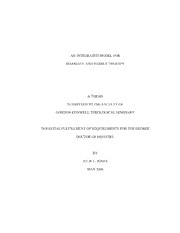Table Of ContentAN INTEGRATED MODEL FOR
MARRIAGE AND FAMILY THERAPY
A THESIS
SUBMITTED TO THE FACULTY OF
GORDON-CONWELL THEOLOGICAL SEMINARY
IN PARTIAL FULFILLMENT OF REQUIREMENTS FOR THE DEGREE
DOCTOR OF MINISTRY
BY
JULIE L. JONES
MAY 2008
DEDICATION
It is with heartfelt love and sincere gratitude that I dedicate this thesis to my husband,
partner in ministry, and best friend, Kevin Jones. His unconditional love and support,
together with his sacrificial giving of time and resources, have contributed greatly to the
completion of this doctoral program.
Additionally, I wish to dedicate this thesis to my mother, Olive Lalonde, whose modeling
of love, respect, endurance, and determination has contributed to the person I am today.
iv
CONTENTS
LIST OF TABLES vii
ABSTRACT viii
Chapter
1. INTEGRATIVE MODEL 1
Introduction 1
Family Systems Theory 2
Bowen Family Systems Theory (BFST) 6
Biblical Understanding of Persons 24
2. BIBLICAL ANTHROPOLOGY 27
Introduction 27
Creatureliness 28
Co-Humanity 28
Imago Dei 29
Sin 34
Sexuality 38
Marriage 38
Family 41
Change 43
3. LITERATURE REVIEW 49
Integration 49
Family Systems Theory 53
Bowen Family Systems Theory 57
v
Theological Anthropology (Personhood, Imago Dei, Sin) 58
Marriage, Sexuality, Family 59
Theory of Change 61
4. CASE STUDY 62
Identifying Information 62
Relevant History 62
Current Mental Status 70
Psychological and Spiritual Formulation 71
Family 83
Diagnosis 85
Ongoing Issues and Challenges 86
Treatment Plan 89
5. CONDUCT AND PROGRESS OF THERAPY 93
Introduction 93
Therapist Role 93
Couple Tasks 95
Therapeutic Goals 95
Emotional/Spiritual Goals 96
Conduct of Therapy 96
Reflections on Therapy 102
Personal Learning Factors 103
Summative Statement 103
vi
REFERENCES 105
VITA 112
vii
TABLES
Table
1:1 Systems Terminology 5
1:2 Chabot Emotional Differentiation Scale 10
1:3 Differentiation of Self Inventory 11
1:4 False Self-Symptoms 12
1:5 Seven Laws of Emotional Triangles 13
1:6 Family Triangulation 13
1:7 Duvall’s Stages of the Family Life Cycle 18
2:1 Creation/Fall – Structure and Function 32
2:2 Essential Character of Sin 35
2:3 Who I Am in Christ 37
2:4 Change from a Systems Perspective 43
2:5 Emotional/Spiritual Health Inventory 46
4:1 Emotional/Spiritual Maturity Categories 74
viii
ABSTRACT
The proposed model is an integrative approach to marriage and family therapy
embracing concepts, techniques, and processes from Family Systems Theory and Bowen
Family Systems Theory. Unique to this integrative approach is the inclusion of a biblical
understanding of persons. An in-depth biblical anthropology is presented in chapter two,
with an informative literature review in chapter three. A case study is presented in
chapter four, which is discussed therapeutically in chapter five.
1
Chapter 1
Integrative Model
Introduction
The internal complexities of individuals and the interpersonal dynamics of
familial relationships are multifaceted. “Human beings are complicated, thinking, feeling,
and acting creatures, who exist in a complex system of biological, psychological, and
social influences” (Nichols & Schwartz, 1998, p. 423), and as such require a family
therapy model that acknowledges and considers each of these domains in an integrative
fashion. Concepts generally employed in family therapy are borrowed from multi-
disciplinary fields such as “biology (systems), physiology (homeostasis), cybernetics
(feedback), psychosomatic medicine (the social context of illness), community mental
health (the therapeutic community), anthropology (structuralism, functionalism, the
participant observer), and social work (the social context of problems)” (Nichols &
Schwartz, 1998, p. 110). The purpose of this chapter is to propose an integrative model
that will employ concepts from each of these disciplines.
It is essential that this integrative model recognizes and comprehends the family
as a social unit, or a system, and yet addresses cognitive, affective, behavioral, spiritual,
and relational aspects of the individual members, and is able to identify the relational
factors that contribute to the character and personality of each person. Additionally, when
conducting family therapy, it is imperative to understand individual members in the
larger context of the family in order to fully understand circular causality.
Three elements are included in this integrative model, which are (1) Family
Systems Theory, (2) Bowen Family Systems Theory, and (3) a biblical understanding of
2
persons. The component from family systems theory that will contribute to this model is
systems thinking, wherein it provides a construct for understanding the manner in which
systems work. Bowen Family Systems Theory is a therapeutic model that compliments
systems thinking in a practical way and helps in comprehending the functionality of
human relationships within a systemic framework. It views the family as a system
without minimizing the individual member’s integrity, and acknowledges system
dynamics insofar as multigenerational influences and nuclear family processes as well as
acknowledging that change in one person can trigger change in the whole system.
A biblical understanding of persons is complementary to the above two elements
and provides an accurate understanding of anthropology.
These three elements, systems thinking, Bowen family systems therapy, and a
biblical understanding of persons contribute to the proposed integrative family counseling
model. One way to think about these three elements in a complementary way is by
imagining systems thinking as the skeleton, Bowen Family Systems Therapy as the flesh
on the skeleton, and biblical personhood as giving life to the human being. A brief
introduction to each of these elements follows.
Family Systems Theory
One of the foundational elements of family is structure, “how it arranges,
organizes, and maintains itself at a particular cross-section of time … [and a second
element is process] … the way it evolves, adapts, or changes over time” (Corsini and
Wedding, 2000, p. 376). In this view, the family is perceived as a system, “a complexly
organized, durable, causal network of related parts that together constitute an entity larger
than the simple sum of its individual members” (Corsini and Wedding, 2000, p. 376). The

